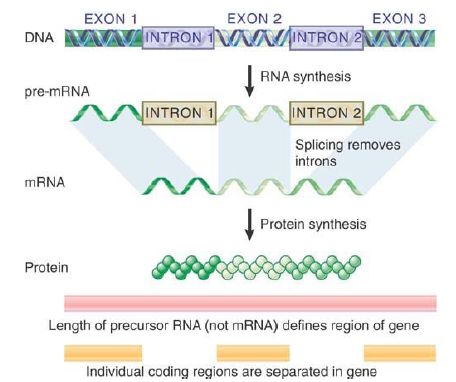


 النبات
النبات
 الحيوان
الحيوان
 الأحياء المجهرية
الأحياء المجهرية
 علم الأمراض
علم الأمراض
 التقانة الإحيائية
التقانة الإحيائية
 التقنية الحيوية المكروبية
التقنية الحيوية المكروبية
 التقنية الحياتية النانوية
التقنية الحياتية النانوية
 علم الأجنة
علم الأجنة
 الأحياء الجزيئي
الأحياء الجزيئي
 علم وظائف الأعضاء
علم وظائف الأعضاء
 الغدد
الغدد
 المضادات الحيوية
المضادات الحيوية|
Read More
Date: 31-12-2015
Date: 18-3-2021
Date: 5-5-2016
|
Introduction to the interrupted Gene
The simplest form of a gene is a length of DNA that directly corresponds to its polypeptide product. Bacterial genes are almost always of this type, in which a continuous sequence of 3N bases encodes a polypeptide of N amino acids. However, in eukaryotes, ribosomal RNAs (rRNAs), transfer RNAs (tRNAs), and most messenger RNAs (mRNAs) are first synthesized as long precursor transcripts that are subsequently shortened . Thus, eukaryotic genes are usually much longer than the functional transcripts they produce. It is reasonable to assume that the shortening involved a trimming of additional, perhaps regulatory, sequences at the 5′ and/or 3′ end of transcripts, leaving the rRNA or protein-encoding sequence of the precursor intact.
However, a eukaryotic gene can include additional sequences that lie both within and outside the region that is operational with respect to phenotype. Protein-encoding sequences can be interrupted, as can the 5′ and 3′ sequences (UTRs) that flank the protein-encoding sequences within mRNA. The interrupting sequences are removed from the primary (RNA) transcript (or
pre-mRNA) during gene expression, generating an mRNA that includes a continuous base sequence corresponding to the polypeptide product as determined by the genetic code. The sequences of DNA comprising an interrupted protein-encoding gene are divided into the two categories (see FIGURE.1):

FIGURE .1 Interrupted genes are expressed via a precursor RNA. Introns are removed when the exons are spliced together. The mature mRNA has only the sequences of the exons.
-Exons are the sequences retained in the mature RNA product. A mature transcript begins and ends with exons that correspond to the 5′ and 3′ ends of the RNA.
-Introns are the intervening sequences that are removed when the primary RNA transcript is processed to give the mature RNA product.
The exon sequences are in the same order in the gene and in the RNA, but an interrupted gene is longer than its mature RNA product because of the presence of the introns.The processing of interrupted genes requires an additional step that is not necessary in uninterrupted genes. The DNA of an interrupted gene is transcribed to an RNA copy (a transcript) that is exactly complementary to the original DNA sequence. This RNA is only a precursor, though; it cannot yet be used to produce a polypeptide. First, the introns must be removed from the RNA to give an mRNA that consists only of a series of exons. This process is called RNA splicing (see the chapter titled Genes Are DNA and Encode RNAs and Polypeptides) and involves precisely deleting the introns from the primary transcript and then joining the ends of the RNA on either side of each intron to form a covalently intact molecule (see the chapter titled RNA Splicing and Processing).
The original eukaryotic gene comprises the region in the genome between points corresponding to the 5′ and 3′ terminal bases of mature RNA. We know that transcription begins at the DNA template corresponding to the 5′ end of the mRNA and usually extends beyond the complement to the 3′ end of the mature RNA, which is generated by cleavage of the 3′ extension. The gene is also considered to include the regulatory regions on both sides of
the gene that are required for the initiation and (sometimes) termination of transcription.



|
|
|
|
4 أسباب تجعلك تضيف الزنجبيل إلى طعامك.. تعرف عليها
|
|
|
|
|
|
|
أكبر محطة للطاقة الكهرومائية في بريطانيا تستعد للانطلاق
|
|
|
|
|
|
|
العتبة العباسية المقدسة تبحث مع العتبة الحسينية المقدسة التنسيق المشترك لإقامة حفل تخرج طلبة الجامعات
|
|
|